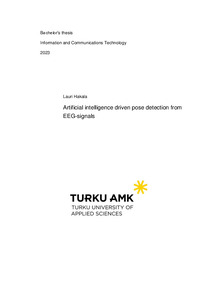Artificial intelligence driven pose detection from EEG-signals
Hakala, Lauri (2023)
Julkaisun pysyvä osoite on
https://urn.fi/URN:NBN:fi:amk-2023120233698
https://urn.fi/URN:NBN:fi:amk-2023120233698
Tiivistelmä
The objective of this thesis was to collect EEG- and AI detected human pose data, to be used as data for training a new AI capable of inferring human poses from EEG. The idea is that such an AI could be used to translate EEG into machine readable input and used to control devices.
Starting with data collection, two programs were written in Python to record pose keypoint data and EEG. Post recording, the data was processed with another Python program, eliminating extraneous data points and applying specific filters. Once the data was prepared, it was used to train an AI that would interpret poses from EEG. Half a dozen variations of the AI were trained with differences in how many steps they were trained and how the data was split during preparation. The AI variations were tested and the difference in data preparation had no discernible impact on performance, but the number of training steps did.
Although the final AI model was limited to recognizing a stationary human pose, a limitation attributed to the data presentation method during training, the research successfully demonstrates the concept's viability.
Starting with data collection, two programs were written in Python to record pose keypoint data and EEG. Post recording, the data was processed with another Python program, eliminating extraneous data points and applying specific filters. Once the data was prepared, it was used to train an AI that would interpret poses from EEG. Half a dozen variations of the AI were trained with differences in how many steps they were trained and how the data was split during preparation. The AI variations were tested and the difference in data preparation had no discernible impact on performance, but the number of training steps did.
Although the final AI model was limited to recognizing a stationary human pose, a limitation attributed to the data presentation method during training, the research successfully demonstrates the concept's viability.
